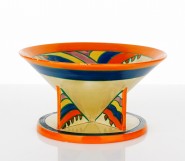Lot #47 - § Robert Klippel
-
Auction House:Mossgreen
-
Sale Name:Fine Australian & International Art
-
Sale Date:29 Aug 2016 ~ 6.30pm - Part 1 (Lots 1 - 78)
30 Aug 2016 ~ 2.30pm - Part 2 (Lots 79 - 328) -
Lot #:47
-
Lot Description:§ Robert Klippel
(1920-2001)
Untitled 1950
ink, gouache and silverpaint
52 x 37 cm
signed and dated lower centre: Robert Klippel 1950 -
Provenance:Margaret Cilento, Melbourne; By descent; Private collection, Sydney; Important Australian & International Art, Sotheby's Australia, Melbourne, 26 November 2013, lot no. 60; Private collection, Melbourne
-
References:RELATED WORKS: There are a number of Klippel works on paper dated 1950 that have a relationship to the present work in the collections of the National Gallery of Australia and the Art Gallery of New South Wales
-
Notes:In 1950 when Robert Klippel who is regarded as one of Australia's most important sculptors of the 20th century, produced this abstract untitled gouache, ink and silverpaint drawing, he was living in Paris having moved there in 1949 after studying in London for two years at the Slade School of Art. In November 1948 in London Klippel's two-person exhibition with Lucian Freud (1922-2011) was seen by the major Surrealist figure Andr Breton, who arranged for Klippel to have an exhibition with the Gallerie Nina Dausset in Paris the following year. During the 18 months that Klippel spent in Paris, he focused on sketches and works on paper, such as the present work, which reveals his interest in the key avant-garde movements of the time - Cubism, Surrealism and Constructivism, all of which played a major part in the development of his innovative approach to sculpture. Surrealism, in particular, heightened Klippel's interest in the role of chance and the subconscious in creativity; while both Cubism and Constructivism led him to explore the underlying principles of machinery and the structures of nature expressed through assemblage. His works thus came to embody as he described, 'the language of forms',1 meaning that the structure and overall composition of his sculptures, drawings and collages with their intricate relationships of elements is like a vocabulary. He believed that the nature of art is 'to give life to forms' and as a consequence many commentators, notably his friend and artist James Gleeson, have described his works as being analogous to a piece of music, where various notes and tones coalesce to form the whole.2 Klippel's formative years as an artist were overshadowed by the events of the Second World War and its aftermath, acutely felt in post-war London and Paris. It was a period of questioning for many artists who responded to the existentialist tenor of the time so well expressed in the poetry of T. S. Eliot, and encapsulated in Klippel's thoughts on his own approach: "As Eliot says, the way up is the way down, the way forward is the way back My way is through something tangible, through forms, you know shapes, or whatever you like to call it. I call the thing that I am interested in, 'the language of forms'. That means it's just not shapes in relationship it brings the whole person to bear, all the aspects of oneself all coming through one's hands, the mind and the emotions, the intellectual aspect, everything, the total self".3 Robert Klippel was also deeply interested in philosophy, and his reading of the spiritual texts of Krishnamurti (1895-1986) and other Indian philosophers such as Ananda Coomaraswamy (1877-1947), led him to an understanding and appreciation of Zen in the broadest sense. This infused his approach to his practice as he mastered the art of combining disparate and seemingly paradoxical elements - simplicity and complexity, perfection and imperfection, the mechanical and the organic - skillfully orchestrating them to co-exist in a new order of balance and equilibrium. The present work reveals just how successful Klippel was at orchestrating his understanding of the dynamics of energy and balance in drawings, collages and sculptures. When he returned to Sydney in 1963 Klippel began incorporating found objects into his sculptures using engine parts and bits of machinery such as the keys from typewriters; and over the following decades he also constructed sculpture from wooden elements, including machinery pattern parts, plastic toy elements and packaging, many of which were utilised in their original state while others were cast in bronze. All of which has constituted a major achievement with an oeuvre of lasting significance to Australian art. Frances Lindsay AM 1. James Gleeson, 'The nomenclature of Klippel's works', in James Gleeson, Robert Klippel, Bay Books, Sydney & London, 1983, p.9; see also Frances Lindsay, Klippel/Klippel: Opus 2008, National Gallery of Victoria, 2008, p.3 2. Robert Klippel, interview with Hazel de Berg, 1965, tape 93 p.994. NLA; see also Deborah Edwards, Robert Klippel, Art Gallery of New South Wales, 2002; also quoted in Deborah Edwards,'Make it new', Art & Australia, Vo.40, No.1, 2002 3. ibid. § Indicates that Resale Royalty of 5% will be applied to the hammer price of this work.
-
Estimate:A$8,000 - 12,000
-
Realised Price:
-
Category:Art
This Sale has been held and this item is no longer available. Details are provided for information purposes only.










